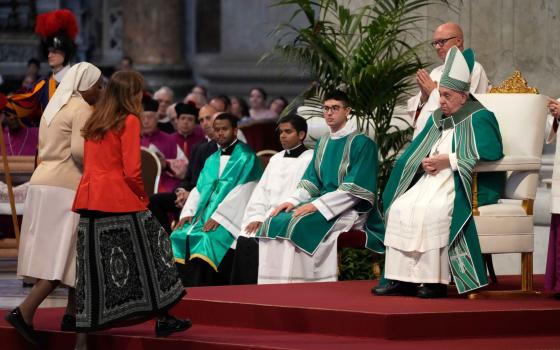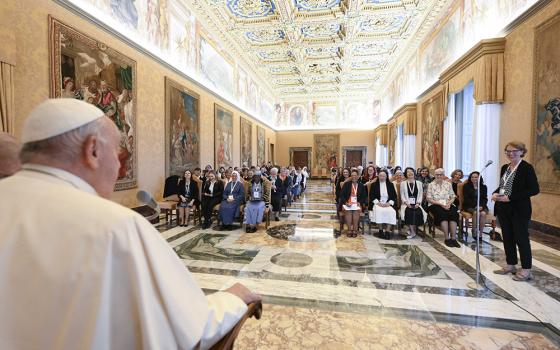
Secretary General of the Synod of Bishops Cardinal Mario Grech, right, delivers his speech during a presentation of the new guidelines for the Synod of Bishops at the Vatican June 20. At left is Helena Jeppesen Spuhler, a synod participant from Switzerland who was among those presenting the document. (AP/Domenico Stinellis)
The Vatican's synod office has now published the document that will guide the work of the Synod of Bishops that will meet in Rome in October 2023 and October 2024.
The caution church leaders are using in talking about the document, known as an instrumentum laboris, so far contrasts with the salvo of the responses coming from conservative Catholic influencers. One example is the latest anti-Francis article by New York Times op-ed columnist Ross Douthat. Douthat laments that the Catholic Church is about to "water down or just talk less about its teachings on sex and marriage and family, rather than find a way to reassert them or offer them anew" and worries about falling into the trap of "reconciliation with our decadent culture, our depressing post-Dionysian world."
There is no such thing in the synod text, which is not a document of the magisterium and is not definitive nor definition of anything. This particular text is descriptive, in a cautious but honest way, of the issues on the table of global Catholicism today: The synod has not just heard from but has listened to those who engaged in the synodal process, and the preparation for the October assembly reflects this. "This Instrumentum Laboris was drafted on the basis of all the material gathered during the listening phase, and in particular the final documents of the Continental Assemblies," the text states in its forward.
The document is made of two parts. The first is an explanatory text on synodality: how the process unfolded, the importance of synodality in the church of today, and the profound intention of this document, which goes deeper than its procedural function in the preparation for the synod. "The [text] strives to avoid divisive language in the hope of furthering better understanding among members of the synodal assembly who come from different regions or traditions," it states. "The vision of Vatican II is the shared point of reference."
The problem is that some of the most vocal, opinionated and platformed commentators on church affairs have a vision of Vatican II that tends to be cartoonish, and it is quite the opposite of Pope Francis, the Vatican's synod office and the overwhelming majority of Catholics who participated in the synodal process.
The second part of the document is made of 15 worksheets that reveal a dynamic vision of the concept of "synodality" in three sections: communion, mission and participation. This is a changed order from the vademecum published by the General Secretariat of the Synod in September 2021, which was communion, participation and mission. It is in this second part that, in the form of "questions for discernment," the controversial issues appear: women and ministry, the model of priesthood, and clericalism.
An important choice was to organize the inputs in the text thematically and not geographically, that is, without emphasizing the issues that are typical of the Catholic Church in one continent and emphasizing others that are typical in another continent. These differences exist, but our plural global Catholicism is everywhere locally in the world today, and it's not easy to divide sharply between different kinds of regional Catholic identities. The synod document takes into account that we live in a world of "believers without borders" — something that was not quite there at the time of Vatican II.

Sr. Nadia Coppa, president of the women's International Union of Superiors General, speaks to reporters at the presentation of the working document for the Synod of Bishops at the Vatican press office June 20. (CNS/Lola Gomez)
For the first time since Vatican II, and more than for the preparation of Vatican II, there has been an in-depth back and forth between the local churches and the leaders of the synod. The text represents this and puts the issues on the table without regard to taboos. The only issue it explicitly leaves out is the possibility of the ordination of women to the priesthood, which, if put on the agenda today, would light the fuse of the anti-synodal and schismatic organizers instantly.
The text instead poses the question of the promotion of the baptismal dignity of women. It is very aware of the opposition not only against changes that could be decided in the future, but also of the opposition and inaction against what Francis decided already. For example, his formal opening of the ministries of lector and acolyte to women, and his creation of the new official ministry of catechist.
But one question for discernment in Part B of the document is very clear: "Most of the Continental Assemblies and the syntheses of several Episcopal Conferences call for the question of women's inclusion in the diaconate to be considered. Is it possible to envisage this, and in what way?"
The text keeps the debate open, with little hints about what can and cannot be done, but also without raising unrealistic expectations. It mentions the issue of the reform of formation of future priests, the debate on the ordination to the priesthood of married men and the renewal of episcopal ministry in a synodal church. It makes clear that this preparatory document and the whole process must be understood as part of a two-session synod, which will be held in Rome in October 2023 and October 2024. It also has a longer perspective, considering the synod process as a new phase in the reception of Vatican II.
Some of the most vocal, opinionated and platformed commentators have a vision of Vatican II that tends to be cartoonish, and it is the opposite of Pope Francis, the Vatican's synod office and the overwhelming majority of Catholics who participated in the synodal process.
The ecclesiological part of the document is unfinished, maybe on purpose, as the writers clearly want to tread lightly on the ongoing synodal journey. It relies heavily on Lumen Gentium alone: The text's explicit references to Vatican II are almost exclusively limited to the Constitution on the Church. This reflects the fact that Vatican II has a theology of the episcopacy, but it does not have an unequivocal theology of the priesthood (for example, the synod text quotes only from Lumen Gentium 28, not from Presbyterorum Ordinis, the Council's Decree on the Ministry and Life of Priests).
The text seems to ignore Francis' 2016 apostolic exhortation Amoris Laetitia and its ecclesiology of the family. The word "marriage" is used only once in reference to the pastoral challenges posed by polygamous marriage; "spouses" only in the case of interdenominational marriages; and, the words "family" and "families" are still predominantly used as objects of attention, not as ecclesial subjects.
Interestingly, this contrasts with what the text acknowledges: "The syntheses of the Episcopal Conferences and the Continental Assemblies repeatedly call for a 'preferential option' for young people and families, which recognizes them as subjects and not objects of pastoral care." Moreover, the text mentions the role of the local churches in the discernment of "ministries." Could this perhaps be a step forward from the partial rejection of the proposals of the 2019 Synod for the Amazon Region on married priests, as made in Francis' 2020 exhortation Querida Amazonia?
The major issue is the vaste programme of the third section of the second part, centered on the reform of the overall ecclesiological architecture of the church in the context of synodality. It discusses papal primacy, episcopal collegiality (including in the bishops' synod, and in bishops' conferences) and priestly ministry.

Italian Jesuit Father Giacomo Costa, second from left, adviser to the secretary-general of the synod, speaks at a news conference at the Vatican Oct. 27 to present the document for the continental phase of the Synod of Bishops on synodality. Also pictured are Msgr. Piero Coda, secretary-general of the International Theological Commission; Cardinal Mario Grech, secretary-general of the Synod of Bishops; Anna Rowlands, professor of Catholic social thought and practice at Durham University in the United Kingdom; and Matteo Bruni, director of the Holy See Press Office. (OSV/CNS/Junno Arocho Esteves)
In the question for discernment in part B 3.5, the text hints clearly at the experimental nature of the synodal process: "how should the institution of the Synod be perfected so that it becomes a secure and guaranteed space for the exercise of synodality that ensures the full participation of all—the People of God, the College of Bishops and the Bishop of Rome—while respecting their specific functions?"
Even more interesting is that Francis' recent expansion of the synod to include lay voting members, including women, for the first time is called an "experiment." It seems the changes in the synod's structure might not be permanent.
The ecclesiological questions being touched by the synod process are the riskiest, even more so than the questions about women, married priests and the inclusion of LGBTQ Catholics.
This might be one reason the question of "participation" has been moved and is now the third and last in order, after "mission." It is unlikely that this assembly of the synod or the next will be able to address these very complex architectural dilemmas: the role of the papacy, of episcopal conferences, of regional patriarchates in a synodal church dealing with a high degree of global diversities.
Advertisement
While these issues are on the radar, Francis' synod seems better equipped to deal with more basic questions on recognition and inclusion of all members of the church at the local level.
The text has the Francis genius, and also some weaknesses. But it's honest and hopeful. It is a re-elaboration and preparation for the synod of the material that came up from the global consultation process, without bending it to a particular theological option, and without denial of reality. It is nonsense to accuse it of tilting the synodal process in favor of an agenda, either the pope's or anyone else's.
This is a very delicate moment in the life of the Catholic Church. This text reflects the very diverse positions and sensibilities on some issues (examples: sexuality, women and secularization) between different local churches. "Global Catholic" today means being all over the place and in plain sight. And it's not the fault of the synod, of Francis or of Vatican II.








